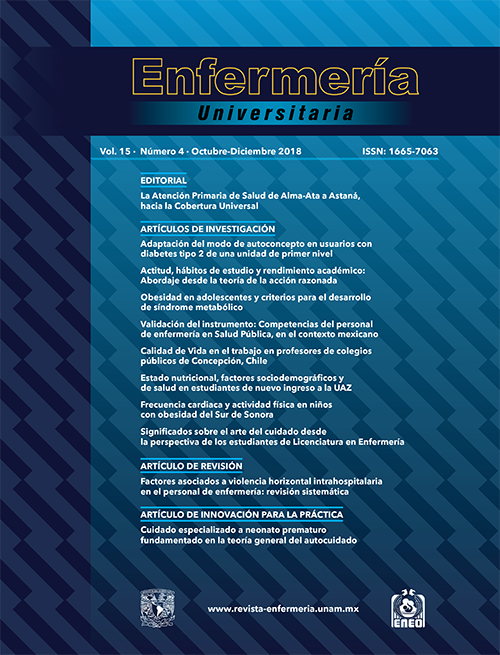Adaptation of the self-concept mode in users with diabetes type 2 in a first level unit
Main Article Content
Abstract
Objective: To compare the level of Adaptation of the Self-Concept (ASC) in persons suffering from Diabetes mellitus type 2 (DT2) in two locations at a first level unit. Methodology: This is a descriptive, correlational, comparative, and transversal research with a sample by convenience of adults with DT2 attending to a monthly control, and to a Mutual Support Group MSG, both in a first level unit. The general data register and the Viveros03 instrument (α=.85) were used. Anthropometric and capillary glycemic level assessments were performed. Data were analyzed through SPSS v.20. The hypothesis was verified using Shapiro-Wilk, T-student and Chi square tests.
Results: There were 50 participants, the 25 in the MSG were assigned to group A, while the other 25 constituted the ambulatory and group B. ASC in group A was 60% while 68% in group B; the difference was significant at p = 0.002. Contextual stimuli such as capillary glycemic level, and years of diagnosis and treatment did not show dependence (p>.05) contrary to family diabetes background, and belonging to the MSG, which did show an association (p=.05).
Conclusion: ASC was better among those in the MSG, while family background promoted a better adaptation as well.
Publication Facts
Reviewer profiles N/A
Author statements
- Academic society
- N/A
- Publisher
- Universidad Nacional Autónoma de México
Article Details
Dimensions citation
MÉTRICAS

This work is licensed under a Creative Commons Attribution-NonCommercial-NoDerivatives 4.0 International License.
Enfermería Universitaria by Universidad Nacional Autónoma de México it is distributed under the License Creative Commons Attribution - NonCommercial - NoDerivatives 4.0 International
Accepted and published articles become open-access under the terms of the Creative Commons CC BY-NC-ND 4.0 license, which authorizes the reproduction and sharing without commercial purposes, provided the corresponding acknowledgments to their authors. Authors are allowed to manage a self-archive copy of the article’s published version so that they can open-access it in their personal or institutional web pages, and/or any other broad-diffusion space.


